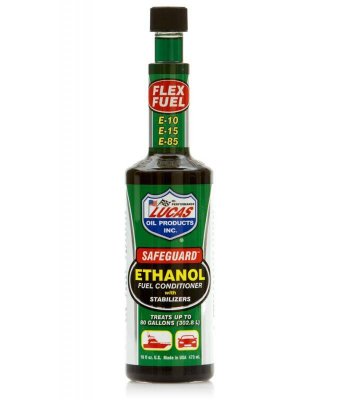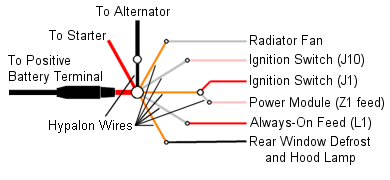I just read ten pages and here's what I got out of it....I'm very grateful that my car isn't show quality, nor 100% stock/oem. Throw in a circuit breaker or ATO fuse and be done with it.
How many AMPS is this fusible link rated for?
Maybe this may help, :book1:
http://www.minimopar.net/electrical-links.html
Electrical Issues: Fusible Links
Description
The page describes how to diagnose and repair fusible links. Fusible links are the electrical system's last line of defense against electrical fires. They distribute power to the main parts of the electrical system and carry loads far greater than any automotive fuse can handle.
Diagnosis
If your vehicle is an 1989 or earlier model, then you probably have hypalon wire fusible links. These look just like regular wires, except the insulation is made out of a special, flame-proof material. The easiest way to test them is to tug on them. A blown link will stretch like a rubber band. The diagram below shows a typical A1 distribution (using hypalon wires, based off of 1987 configuration).
Later models have a power distribution center under the hood, near the battery which contains a bank of MAXI fuses that serve as the fusible links. The underhood relays are also located here. These look like large automotive fuses and can be visually inspected.
See the
Electrical Issues: Main Power Feeds page for specific diagnosis of the various circuits.
Repair
This section concentrates on repairing the older hypalon fusible links, since the MAXI fuses can simply be replaced. There are a couple of ways to repair a hypalon fusible link, depending on how the link blew. It is important to understand why the link blew in the first place before repairing the link. Once the root cause has been addressed, the link may be repaired using one of these methods:
Temporary Patch
To aid in diagnosing the root cause, a temporary patch may be made depending where the link blew. If the link blew somewhere along the length of the wire within an inch of each end, the link can be spliced back together by stripping about 1/2 inch of insulation off of each end of the link and connecting it back together with a crimp-on butt connector or by twisting the link wire together and using a wire nut. Note that this should
not be done as a perminant fix, as the spliced link will not have the correct current rating and the connection will be prone to failure due to corrosion.
Replacing the Link
Fusible link wire may be purchased at most auto parts stores. The correct gauge and length of wire must be used in order to achieve the correct current rating. The following table lists the Chrysler color coding on its hypalon fusible links. Be sure to cut the new link to match the length of the original.
| Color | Wire Gauge |
| Black | 12 |
| Red | 14 |
| Dark Blue | 16 |
| Grey | 18 |
| Orange | 20 |
| White | 22 |
When replacing the link, cut the old link completely out of the old wiring and strip about 1/2 inch of insulation off of each wire and the each end of the link. If this link is off of the rubber multiple connection insulator, cut the old link flush to the insulator and strip about 1 inch of insulaton off of the A1 feed wire just before the insulator. Then solder the new link to the wires and wrap the connections with electrical tape and then harness tape ("friction tape" at most hardware stores).
Upgrading the Link
Rather than replace the old hypalon link with the same material, you have the option of replacing the link with a more modern replacement. There are two options available. The link can either be replaced with a cartridge-type fusible link ("Pacific Fuse") or a Maxi fuse instead. Pacific fuses come in a few different form factors. The easiest version to adapt is the type with copper lugs that have a hole through them. However, since these Pacific fuses are wired in directly, it makes them more cumbersome to replace again later. Maxi fuse holders are available at most auto parts stores. Since Chrysler switched to Maxi fuses in later models, that is what is recommended.
Selecting the correctly-rated fuse is not straight forward, as the hypalon link current capacity is a function of its size and length. They are generally selected to protect a particular size circuit wire and the general rule of thumb is the fusible link gauge should be 4 less than the circuit it's protecting (thus a 12 gauge circuit will be protected by a 16 gauge fusible link). The chart below uses the Maxi fuse ratings of later model (1989 and up) electrical systems as a guide for Maxi fuse size selection. This is possible because the power distribution did not really change electically on vehicles with the power distribution center, thus the circuit rating could be deduced from this.
| Circuit | Hypalon Link Type | MAXI Fuse Rating | Circuit Wire |
| Alternator Feed (R6) | 12 gauge (black) | 160 amp (2x80 in parallel) | 8 gauge (BK) |
| Radiator Fan (C26) | 20 gauge (orange) | 40 amp | 14 gauge (GY) |
| Ignition Feed (J10) | 18 gauge (grey) | 50 amp | 12 gauge (PK/BK*) |
| Ignition Feed (J1) | 20 gauge (orange) | 40 amp | 12 gauge (RD) |
| ECU/ASD Feed (J1) | 22 gauge (white) | 30 amp | 12 gauge (PK) |
| Direct Battery Feed (L1) | 18 gauge (grey) | 50 amp | 12 gauge (RD/WT*) |
| Heated Rear Window (C13) | 18 gauge (grey) | 40 amp | 12 gauge (BK/RD*) |
| Hazard Flasher (A3) | 20 gauge (orange) | 20 amp | 14 gauge (PK) |
When replacing the link with the Maxi fuse socket, the procedure is much the same as before. Cut the old link completely out of the old wiring and strip about 1/2 inch of insulation off of each wire. If this link is off of the rubber multiple connection insulator, cut the old link flush to the insulator and strip about 1 inch of insulaton off of the A1 feed wire just before the insulator. Then solder a short length of regular copper wire (using the size specified in the table above) to each end of the blown circuit and wrap the connections with electrical tape and then harness tape ("friction tape" at most hardware stores). Then connect the new wires to the Maxi fuse socket. Some sockets have bare screw terminals, which must be insulated with tape and/or heat shrink tubing.


















